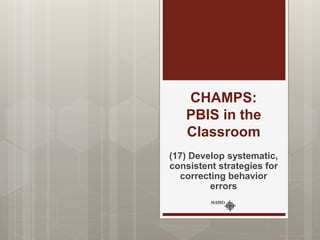
Chp. 9 introduction slides
- 1. CHAMPS: PBIS in the Classroom (17) Develop systematic, consistent strategies for correcting behavior errors
- 2. STOIC Structure the environment Teach behaviors and expectations Observe Systematic supervision Use data to make decisions Interact positively Correct Fluently
- 3. Common Language Misbehavior Inappropriate Behavior Target Behavior Not meeting expectations We need to think of these as Behavior Errors
- 4. “If a child doesn’t know how to read, we teach, If a child doesn’t know how to swim, we teach, If a child doesn’t know how to multiply, we teach, If a child doesn’t know how to drive, we teach, If a child doesn’t know how to behave, we…. John Herner (NASDE President, 1998)
- 5. Common Language Consequence Response Outcome We need to think of these as Corrections in response to the Behavior Errors
- 6. Correction vs. Consequence When you treat student misbehavior as an instructional opportunity, you give students the chance to learn from their mistakes. Sprick, CHAMPS, 2009
- 7. Classroom Management Plan vs. Individual Intervention “Rule of Three”: If more than three students are demonstrating the same misbehavior, the management plan needs to be adjusted to address the misbehavior (use STOIC Checklist).
- 8. Correcting Fluently • Calm • Consistent • Immediate • Brief • Respectful
- 9. What is the outcome of an Effective Corrective Consequence? 1. Changes the future occurrence of the behavior. 2. Allows for instruction to continue. 3. Treats students with dignity and respect. 4. Keeps students motivated to exhibit positive behaviors. 5. Maintains the positive relationships between students and staff.
Editor's Notes
- Essential Elements of SW anc CW PBIS
- Math example. What do we do when a student gets a math problem wrong? Do we punish them for it? No, we tell them to correct it or we help them correct it. If everyone gets it wrong, what do we do? We reteach it. Just like everyone doesn’t grasp the math concept the first time around, it is the same with behavior. Response to behavior errors is to correct.
- DIFFERENTIATE BETWEEN A CORRECTION AND A CONSEQUENCE. When a student finally “gets it” we acknowledge it, they get a good grade. They get it correct! It is the same for behavior. We want to acknowledge when we see positive behavior or when we see students exhibit the expected behavior. We correct it when we don’t see expected behavior.
- Fluently – least amount of interruption to the flow of your instruction Reacting emotionally can impact all of these things, but especially inconsistency. On a bad day we may overreact, but on a good day, we may underreact. For example, your class is focused and working and that one student who hums when he works doesn’t really bother you right now so you ignore it. The next day your class is a little louder, your lesson didn’t go as planned, things are more chaotic, and you tell the student if he doesn’t stop humming you’re going to have to send him out. OR you consistently let your 4th period students come in late to class after lunch and don’t really acknowledge it, but that one day you had a rough class before, you decide you’re going to lock them all out and not let them in. Emotions are impacting the way you respond, which leads to inconsistency and could reinforce the behavior errors. “I know I have to be on time for Schrumpfs class because she’ll keep me after if I’m late, but I know I can be late to Russells class because she doesn’t keep track of tardies. MODEL the behavior we expect to see: teacher is late, but marks kids tardy. Teacher yelling at her kids in the hallway for being loud in the hallway. Pencil Tapper, humming
- Changes doesn’t necessarily mean extinguishes, in the case of severe chronic misbehavior. We might be looking at a reduction in the frequency and hopefully the intensity.